#1053 – Dick Bernard: Aunt Edithe's Recipes
The harvest season has had a strong beginning out in North Dakota, and will continue on into the fall. Depending on the crop, now is a time of vibrant yellows (wheat and similar grains), or rich greens (corn, soybeans, et al). (Indications are that this will be a pretty good crop year – though such is never certain for farmers until the crops are actually in…and then comes bad or good news about prices, etc….)
As for me, I continue the never-ending discovery process of going through the history left behind at the ND farm when Uncle Vince died on February 2 (his sister, Edithe, who was a lifelong resident of the same farm, died a year earlier).
Once in awhile there are remarkable discoveries, among which was this photo from harvest time 1907, which I didn’t know existed.
(click to enlarge all photos)
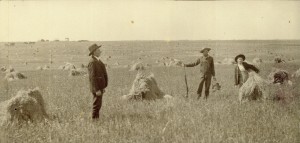
Ferd and Rosa Busch farm (upper left) in summer 1907, viewed from the north. From left, Wilhelm Busch; his sons Ferdinand and Frank. At the time, Ferdinand was 26 years of age.
You can see the 1907 harvest proceeding. The shocks of grains dominate, and to the left in the background are a couple of horse drawn wagons to move those shocks to some kind of early threshing machine, not visible in the picture*.
But this is not about those men pictured out in the field. It is about the lady in the house, Rosa, and later her daughter Edithe, and other daughters, and other women, who had the immense task of feeding the workers in the fields, milking the cows, collecting eggs, and on and on and on. The phrase, “a woman’s work is never done” could have originated in these farmyards. As could the phrase, “hungry as a horse” have originated out in those fields.
Last week I was going through yet another stack of old papers, deciding which needed to be kept, and which could be thrown. In the box of the day was a bag full of Aunt Edithe’s old recipes which we’d rescued from the long vacant farm house last summer. As with the other stuff, I went through the recipe cards, one by one, and at the end, took a picture of part of the collection (below).
My particular specialty has always been eating the results of the recipe cards, but these cards held a fascination of their own. Just looking through these old cards, which women, primarily, have exchanged forever, brought forth memories. Someone saying, “that was delicious. Can I have the recipe?” Someone else flattered and happy to oblige.
Perhaps the best tribute to Edithe came to me from cousin Glenn Busch of Freeport IL on Dec. 24, 2014: “Sandy and I will always remember the wonderful meal [Edithe] prepared for us and our family when we visited ]the] farm back in the early 1980’s. She went far beyond anything we expected. After about 30 years , I still remember that it was some of the best beef roast I’ve ever had. The hospitality that she and Vince showed us was really outstanding….”
Among the recipes were the staples: for pickles of all sorts, doughnuts, assorted desserts, etc. Lefse made a couple of appearances in the German household recipe box. Anyone who has a single recipe card likely knows the variety found in the stack. Among them were some that I found fascinating, which are included below with little comment – none is needed.
They were all reminders to me that in this world where men still, by and large, are “on the marquee” as the important people, it is the women who bear the children and a great deal of the burden of making any family or community work. Ferd was part of a team with Rosa; brother and sister, Vince and Edithe, were a team, too.
So those recipe cards of Edithe’s which we found above the stove in the farm house are far more than simply patterns for delicious foods; rather of a necessary partnership.
A simple “thank you” is not enough, but a little thanks is much better than none at all.
Thanks for the memories.
Here are a smattering of the recipes….
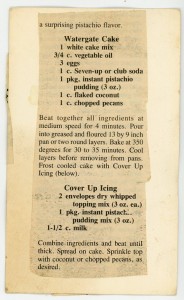
An apparent political statement recipe likely found in a farm magazine dating from the fall of 1974.
And, finally, a recipe for Lady Bird Johnson White House Pecan Pie, dating from March 2, 1964: Recipe #6006 (The date was found on the reverse side of the clipping, and the reason why the cooks face doesn’t appear is that another article on the reverse had also been clipped!)
Bon Appetit!!!
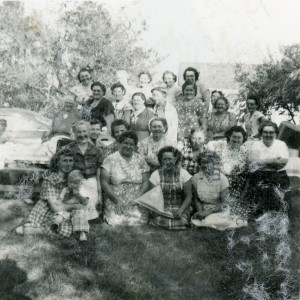
A gathering of women, labelled Berlin (ND) picnic September 7, 1952. Grandma Busch is at left behind the youngster in front row; Aun Edithe is in the back row, at right.
* – larger scale agriculture involving harvesting of small grains (wheat, oats, flax, etc.) required some kinds of mechanized farm implement to do the job. Such increasingly sophisticated equipment led to the rapid growth of such companies as J. I. Case, John Deere, McCormick-Deering and many others. From cultivating to harvest, it was very hard, dusty, sweaty, often dangerous work, very labor intensive.
This time of year, today, is when the threshing festivals crop up, to demonstrate in a very small way how it was.
The Busch farm in its early years was two quarter sections, 320 acres. In North Dakota, this would be a very small farm today; in 1907 it would have been about average for the typical farm of the day.

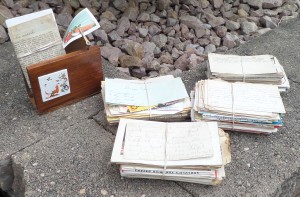
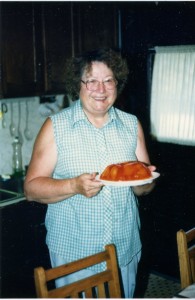
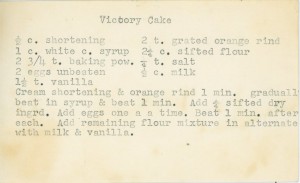
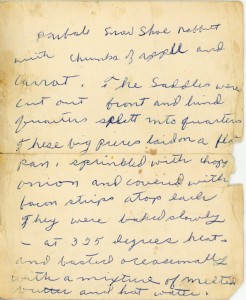
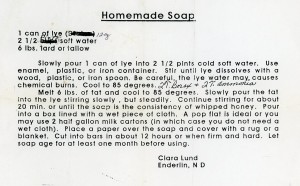
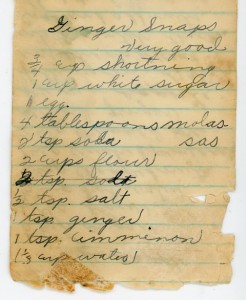
Leave a Reply
Want to join the discussion?Feel free to contribute!